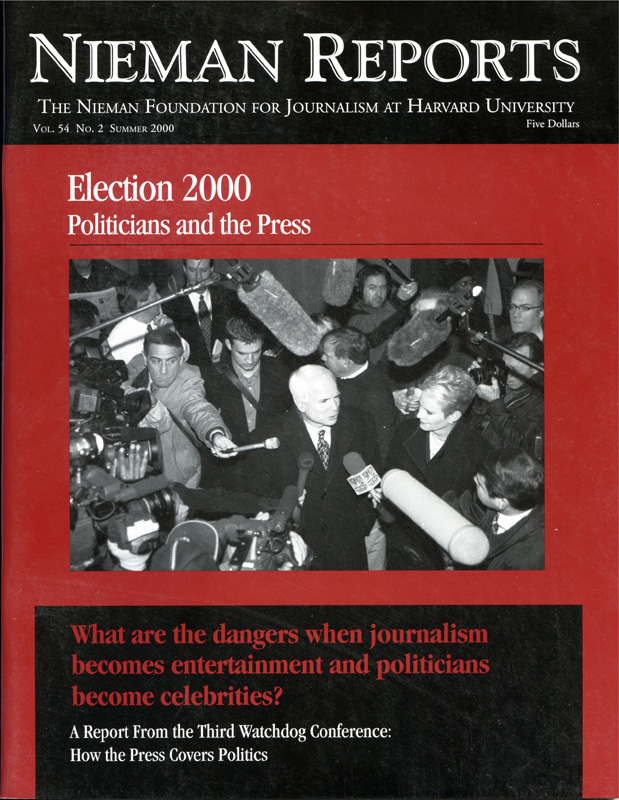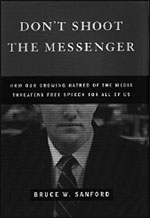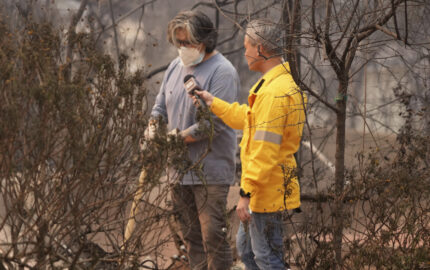There’s nothing like a good First Amendment fight to make journalists feel we’re doing something right for America. But if we listen to media lawyer Bruce Sanford, the battles we’ve fought over the past decade or so have done little to endear us to the public we desperately want to reach.
If this continues, Sanford predicts, we’re all in for an extremely unpleasant future. A bit hyperbolic, maybe, but this prominent First Amendment attorney is clear: The public and the courts have grown increasingly hostile toward the media, and that can only mean erosion of constitutional rights for everyone.
We need the public. And in his book, “Don’t Shoot the Messenger: How Our Growing Hatred of the Media Threatens Free Speech for All of Us,” Sanford makes the point that the public needs us, despite our considerable faults. Who would you rather have looking out for your best interests, the media or the government? The way things are going, most of us probably don’t want to hear the answer. Sanford hammers on the media’s missteps and the price we’re paying for them. It took a couple of decades for us to dig this hole, and Sanford concludes that climbing out requires regaining public confidence—a tall order.
The book doesn’t tell us much we don’t already know about public-opinion polls that fillet us, about libel verdicts and court losses, about the stereotypes we proliferate. But it’s a reality check to view so much bad acting on one stage. “Don’t Shoot the Messenger,” culled from hundreds of interviews, legal cases and reportage, builds a case for virtually unrestricted media freedoms. Sanford’s argument is that every battle lost by the media represents a loss in rights for all.
Sanford cites cases that have been settled rather than tried (the Cincinnati Chiquita case against Gannett among them), and he worries media companies are settling not on the merits of a case but out of fear of jaded juries. He quotes a juror in a record $222.7 million libel case against The Wall Street Journal saying she wanted to punish the media. And Sanford suggests judges may be telling us we don’t respect the rights we have, so why should we be given more?
A quick look in the mirror might be necessary. We have reporters-turned-celebrities debating issues they are supposed to be covering. Media conglomerates—fixated on stockholders and the bottom line—are swallowing up whole markets. Too many companies spend too little on quality journalism, which is the only thing that separates us from “content providers” and “advertorial” producers.
Sanford doesn’t put all the blame on the media. We’re also battling American culture, he says. How do we connect with a public that says news is too biased, sensational and superficial yet can’t seem to get enough of O.J., Monica and “Who Wants to Marry a Multi-Millionaire”?
We as journalists have to assume responsibility, but so must the corporations who own the newspapers, television and radio stations and electronic information sources where we work. I cheer Sanford when he talks about the need to reinvest profits in journalism—the soul of these businesses. And I add that these corporations have a responsibility to make sure there are clear lines between the editorial product and those who advertise in it. In polls, the public indicates it doesn’t put much stock in information on the Internet because the lines are difficult to distinguish. News of such conflicts as the Staples Center fiasco at the Los Angeles Times only deepens suspicion about our motives.
Sanford concludes that people no longer see us as a vehicle for improving life for ordinary Americans. That is hardest to hear. People always have had a love/hate relationship with newspapers but have believed in their fundamental worth, even in the yellow days that inspired the term “muckraking.”
I got into journalism during a heyday, when Woodward and Bernstein were holding a President’s feet to the fire and the courts were slapping government’s overreaching hand. Reporting was a noble calling, and we answered in droves. It was all about questioning authority, exposing wrong-doing, speaking for the little guy, explaining the complex in hopes of helping to change the world for the better.
Most of us haven’t changed our reasons for doing what we do. But Sanford reminds us of how much around us has changed, particularly in this new information age, to widen the rift between the media and the public. People see our hidden cameras and our accompanying police on raids as violations of privacy, not as acting in our capacity as the Fourth Estate, a check on the three branches of government.
Sanford worries, as we all should, that the public has become distracted by the process of journalism and has lost sight of its purpose. He cites hope in the efforts of organizations such as the Committee of Concerned Journalists. Having a singular message is a good thing but walking the talk on a local level is paramount. Newspaper readers, for example, don’t want saber rattling or First Amendment speeches. They want relevant facts, in context, devoid of the journalist’s opinion.
Sanford connects the dots pretty well between action and consequence, but I’m afraid he doesn’t make the case about the severity of the consequences convincingly enough to gain the buy-in of the public. (And some of his arguments—about the need to educate judges about cameras in courtrooms, for example—sound almost patronizing and might actually alienate some readers.)
In the end, journalists might take some solace in Sanford’s observation that the damage to press protections is not all our fault. But his sobering conclusion is: Repairing and strengthening them is entirely up to us—and the companies we work for.
Lorie Hearn is the Metro Editor of The San Diego Union-Tribune. She was a reporter for 20 years before going into editing and is a 1995 Nieman Fellow.
If this continues, Sanford predicts, we’re all in for an extremely unpleasant future. A bit hyperbolic, maybe, but this prominent First Amendment attorney is clear: The public and the courts have grown increasingly hostile toward the media, and that can only mean erosion of constitutional rights for everyone.
We need the public. And in his book, “Don’t Shoot the Messenger: How Our Growing Hatred of the Media Threatens Free Speech for All of Us,” Sanford makes the point that the public needs us, despite our considerable faults. Who would you rather have looking out for your best interests, the media or the government? The way things are going, most of us probably don’t want to hear the answer. Sanford hammers on the media’s missteps and the price we’re paying for them. It took a couple of decades for us to dig this hole, and Sanford concludes that climbing out requires regaining public confidence—a tall order.
The book doesn’t tell us much we don’t already know about public-opinion polls that fillet us, about libel verdicts and court losses, about the stereotypes we proliferate. But it’s a reality check to view so much bad acting on one stage. “Don’t Shoot the Messenger,” culled from hundreds of interviews, legal cases and reportage, builds a case for virtually unrestricted media freedoms. Sanford’s argument is that every battle lost by the media represents a loss in rights for all.
Sanford cites cases that have been settled rather than tried (the Cincinnati Chiquita case against Gannett among them), and he worries media companies are settling not on the merits of a case but out of fear of jaded juries. He quotes a juror in a record $222.7 million libel case against The Wall Street Journal saying she wanted to punish the media. And Sanford suggests judges may be telling us we don’t respect the rights we have, so why should we be given more?
A quick look in the mirror might be necessary. We have reporters-turned-celebrities debating issues they are supposed to be covering. Media conglomerates—fixated on stockholders and the bottom line—are swallowing up whole markets. Too many companies spend too little on quality journalism, which is the only thing that separates us from “content providers” and “advertorial” producers.
Sanford doesn’t put all the blame on the media. We’re also battling American culture, he says. How do we connect with a public that says news is too biased, sensational and superficial yet can’t seem to get enough of O.J., Monica and “Who Wants to Marry a Multi-Millionaire”?
We as journalists have to assume responsibility, but so must the corporations who own the newspapers, television and radio stations and electronic information sources where we work. I cheer Sanford when he talks about the need to reinvest profits in journalism—the soul of these businesses. And I add that these corporations have a responsibility to make sure there are clear lines between the editorial product and those who advertise in it. In polls, the public indicates it doesn’t put much stock in information on the Internet because the lines are difficult to distinguish. News of such conflicts as the Staples Center fiasco at the Los Angeles Times only deepens suspicion about our motives.
Sanford concludes that people no longer see us as a vehicle for improving life for ordinary Americans. That is hardest to hear. People always have had a love/hate relationship with newspapers but have believed in their fundamental worth, even in the yellow days that inspired the term “muckraking.”
I got into journalism during a heyday, when Woodward and Bernstein were holding a President’s feet to the fire and the courts were slapping government’s overreaching hand. Reporting was a noble calling, and we answered in droves. It was all about questioning authority, exposing wrong-doing, speaking for the little guy, explaining the complex in hopes of helping to change the world for the better.
Most of us haven’t changed our reasons for doing what we do. But Sanford reminds us of how much around us has changed, particularly in this new information age, to widen the rift between the media and the public. People see our hidden cameras and our accompanying police on raids as violations of privacy, not as acting in our capacity as the Fourth Estate, a check on the three branches of government.
Sanford worries, as we all should, that the public has become distracted by the process of journalism and has lost sight of its purpose. He cites hope in the efforts of organizations such as the Committee of Concerned Journalists. Having a singular message is a good thing but walking the talk on a local level is paramount. Newspaper readers, for example, don’t want saber rattling or First Amendment speeches. They want relevant facts, in context, devoid of the journalist’s opinion.
Sanford connects the dots pretty well between action and consequence, but I’m afraid he doesn’t make the case about the severity of the consequences convincingly enough to gain the buy-in of the public. (And some of his arguments—about the need to educate judges about cameras in courtrooms, for example—sound almost patronizing and might actually alienate some readers.)
In the end, journalists might take some solace in Sanford’s observation that the damage to press protections is not all our fault. But his sobering conclusion is: Repairing and strengthening them is entirely up to us—and the companies we work for.
Lorie Hearn is the Metro Editor of The San Diego Union-Tribune. She was a reporter for 20 years before going into editing and is a 1995 Nieman Fellow.




